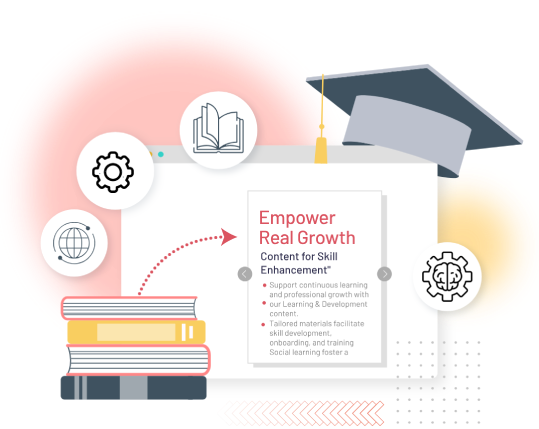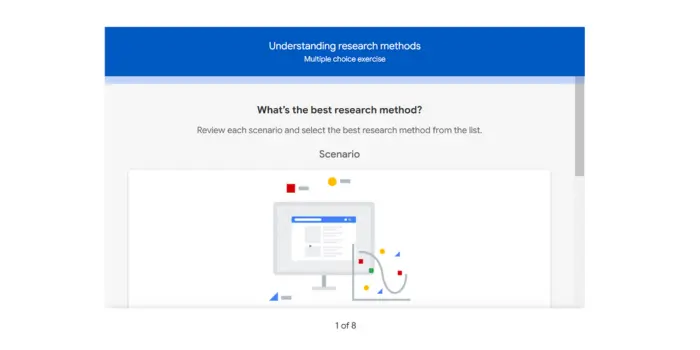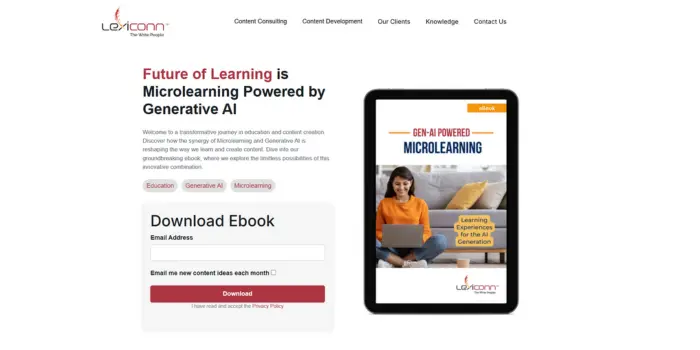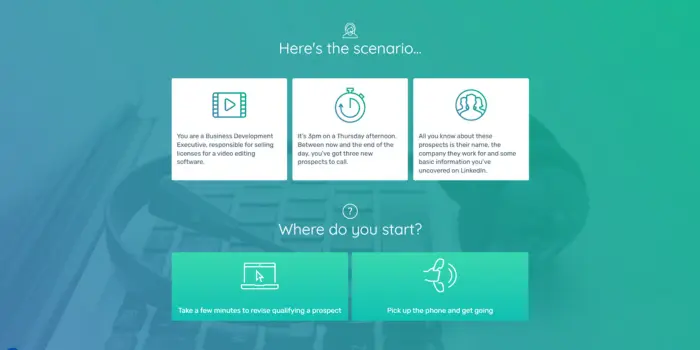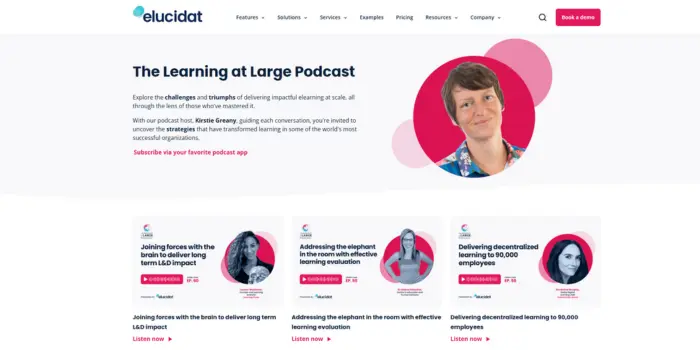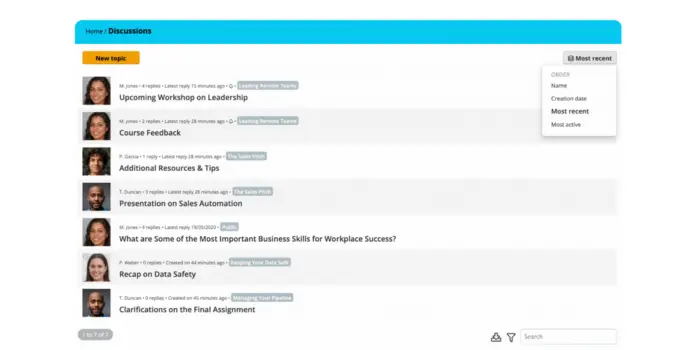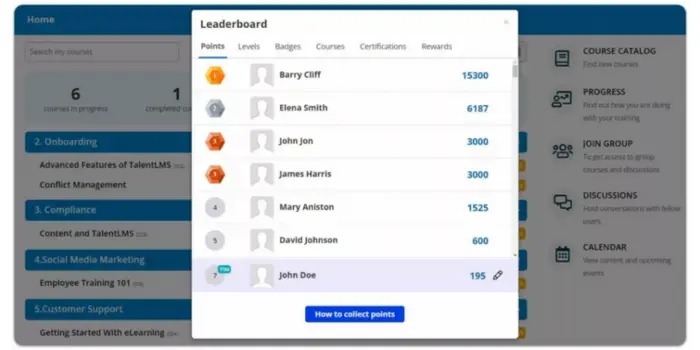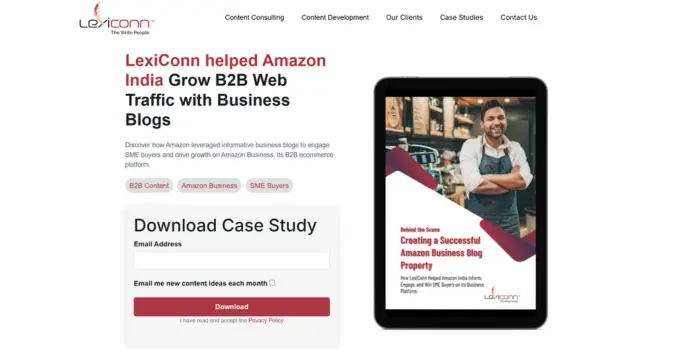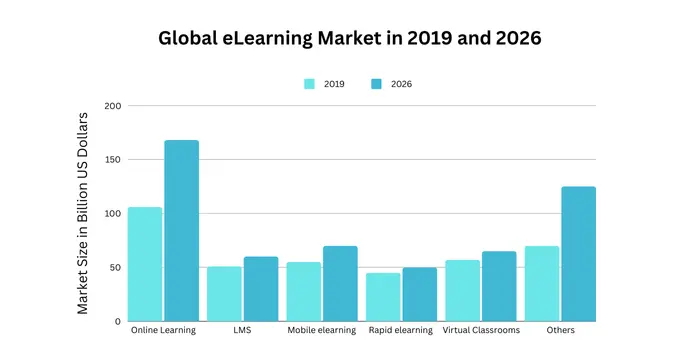ELearning isn’t just about watching videos or clicking through slides anymore. It’s evolved into something much more exciting! From quick microlearning lessons to fun gamified challenges and even immersive virtual reality, there’s an eLearning content type for every kind of learner.
Curious about how these formats are changing the way we learn? Let’s take a look at the top 10 eLearning content types that are shaking up digital education and making it more engaging than ever.
1. Video eLearning
Video content is a popular eLearning content type because it’s already part of people's preferred learning methods. According to a report, teachers have reported that 97% of videos have positively impacted students' learning methods.
In digital education, video is especially effective for learning hands-on skills. Tutorials and step-by-step videos make it easier to follow complex tasks, be they DIY projects or tech fixes. Learners can pause, rewind, or rewatch as much as they need, making the video perfect for covering tricky topics.
This flexible, engaging format fits right into how people already consume content, making learning feel natural and accessible. This multi-sensory approach helps convey information and emotion, making it easier for learners to stay focused and retain what they learn.
Types of Video Content in eLearning
- Instructional Videos: Step-by-step guides that show how to perform tasks or learn new skills. Great for tutorials and demonstrations.
Example: Software walkthroughs or DIY guides.
- Explainer Videos: Short and engaging videos that break down complex ideas into simple, digestible concepts.
Example: Simplifying scientific theories or business strategies.
- Animation & Motion Graphics: Using animations to visually explain abstract ideas or data, making learning more dynamic.
Example: Animated infographics or data-driven graphics.
- Screen Recordings (Screencasts): Recording your screen to show how to use software or navigate digital tools is perfect for practical guides.
Example: Software tutorials or online course navigation.
- Interactive Videos: Videos that allow learners to engage with the content—make decisions, answer questions, and interact during the video.
Example: Branching scenarios or interactive quizzes.
- Lecture Videos: Recorded lectures where an expert explains a topic, often with the help of slides or visuals.
Example: University-style lectures or expert talks.
- Testimonial & Case Study Videos: Real people sharing their experiences, showing how skills or knowledge are applied in the real world.
Example: Success stories or industry expert interviews.
- Vlogs & Behind-the-Scenes: Casual, personal videos offering a sneak peek into topics or experiences.
Example: Showing how ice cream is made in a factory.
|
Here’s an example of a short instructional video by Lexiconn titled "How to Sabotage Your Career."
Source
2. Simulation-Based eLearning
Simulation-based learning is like a playground for your brain! It is an eLearning content type that lets you learn by doing—jumping into real-world scenarios where you can experiment, make decisions, and even mess up, all in a safe environment.
It’s a fun, hands-on way to build skills without the pressure. Digital education takes this even further with digital twins, creating immersive, interactive simulations where you engage with virtual models of real systems for a practical, data-driven learning experience.
When designing simulations, consider the following:
- Keep them realistic and reflective of real-world challenges.
- Let learners explore different approaches, include moments for reflection to boost understanding, and set clear goals.
- Start with simple tasks, then ramp up the complexity.
- Finally, test your simulations with a small group, gather feedback, and fine-tune the experience. This ensures an interactive, engaging learning journey that builds real-world skills.
Types of Simulation-Based eLearning
- Role-Playing Simulations: Focuses on interpersonal skills by placing learners in real-world scenarios where they interact with others, such as handling customer queries or conflict resolution.
- Virtual Reality (VR) Simulations: Immersive experiences ideal for fields like healthcare, engineering, or aviation, allowing learners to practice in lifelike environments.
- Game-Based Simulations: Incorporate gaming elements to teach problem-solving, leadership, or decision-making skills while keeping learners engaged.
- Scenario-Based Simulations: Present realistic scenarios where learners must make decisions that impact outcomes, encouraging critical thinking and strategic planning.
- Equipment-Based Simulations: Used for hands-on training with complex machinery or tools, such as in manufacturing or medical device operation.
|
Here’s an example from Coursera’s UX course, where they present scenarios and guide you in understanding the correct answers.
Source
3. Infographics
An infographic is like a story brought to life with visuals! It turns information, data, or concepts into an easy-to-follow and engaging format. It is a mix of colorful charts, icons, and text that simplifies complex ideas and grabs your attention. In digital education, infographics are powerful tools for quickly presenting information, helping learners absorb key concepts in a visually appealing and digestible way.
Types of Infographics
- Statistical Infographics: These focus on presenting data and statistics in a visual format. Bar charts, pie charts, and graphs are commonly used to make numerical information more accessible and digestible.
- Timeline Infographics: Perfect for showcasing a sequence of events or historical data. These infographics visually display information chronologically, often with arrows or other design elements to guide the viewer through the timeline.
- Process Infographics: These are used to explain a step-by-step process or workflow. They often feature flowcharts, arrows, or numbered steps to make the process easy to follow.
- Comparative Infographics: These compare two or more items, helping the viewer understand differences or similarities. They can use side-by-side charts, tables, or visual elements to highlight key distinctions.
- Geographic Infographics: Often used to present data based on geographic regions, these infographics incorporate maps and geographic visuals to show location-based trends or comparisons.
|
4. Ebooks and PDFs
Let’s say you're learning something new—maybe a new skill or a topic for work. Pulling out your phone or tablet and finding a guide is easier. That’s where eBooks and PDFs come in. You can pause whenever you need to, go back and read something again, and take your time with it. With PDFs, it’s the same idea—you get access to manuals or reference materials that help you understand things in depth. In digital education, eBooks and PDFs offer learners a flexible, on-demand way to access learning materials anytime, anywhere, enhancing the overall learning experience.
Types of Ebooks and PDFs
- Educational eBooks: These are perfect when you want to dive deep into a topic. They are digital education textbooks that walk you through chapters filled with detailed explanations, illustrations, and even exercises to try out.
- Guides and How-To PDFs: Need to get something done without wading through hours of content? These PDFs are your shortcut. They give you clear, step-by-step instructions to solve problems or pick up new skills.
- Research Reports and Whitepapers: Sometimes, you need the hard facts—research, surveys, or detailed case studies that really break down a topic. Whitepapers are often used in business or academic settings, giving you a deep understanding of trends and challenges.
- Workbooks and Worksheets: If you learn best by doing, these are for you. Workbooks and worksheets give you exercises, quizzes, or hands-on tasks to practice what you’ve learned. They’re like a little personal trainer for your brain, helping you build confidence as you go.
- Case Studies and Examples: Case studies show how things work in real life. They’re full of examples, outcomes, and lessons from actual scenarios, making it easier to see how concepts play out in practice.
|
This is an example of an ebook on microlearning by Lexiconn.
Source
5. Quizzes and Assessments
Quizzes and assessments are eLearning content types that are checkpoints that help learners track their progress and increase motivation with instant feedback. They make learning interactive and fun, giving learners a chance to test their understanding while feeling a sense of achievement.
To make a quiz that’s both effective and fun for your digital education:
- Mix up question types like multiple-choice, true/false, and fill-in-the-blanks to keep things fresh.
- Challenge learners, but make sure the questions are fair and achievable.
- Offering instant feedback after each question helps learners understand their mistakes and grow.
- Keep quizzes concise and focus on key concepts. Remember to add a little flair with visuals or scenarios to make the experience more relatable and exciting.
Types of Quizzes and Assessments
- Self-Assessments: Enable learners to evaluate their own understanding before moving forward in the course.
- Final Exams: Summative assessments that test the overall knowledge gained throughout the course.
- Formative Assessments: Smaller, frequent quizzes designed to reinforce concepts learned in each module.
- Interactive Quizzes: Quizzes that include multimedia elements (images, audio, or video) to engage and make learning fun.
- Scenario-Based Quizzes: Present real-life situations where learners can use their knowledge to solve problems, helping them practice skills in a more engaging way.
|
This is an example of a scenario-based quiz created to make assessments engaging and interactive.
Source
6. Podcasts and Audio Lessons
Podcasts and audio lessons offer flexibility in eLearning. They allow learners to consume content while they are commuting, exercising, or doing chores. They complement other eLearning content types by providing an auditory learning experience that reinforces course content.
Creating audio lessons for digital education is like having a friendly chat with your learners.
- First outline the key points you want to cover to keep the eLearning content clear and focused.
- Use a conversational tone to make it engaging, as if you’re talking directly to them.
- Add stories or examples to bring your points to life, and keep each lesson short and easy to follow.
- Good audio quality is a must, so use a decent microphone and record in a quiet space.
- Throw in some music or sound effects to keep things lively, but don’t overdo it.
- Finally, listen back to your recording—if it sounds natural and easy to follow, you're good to go!
Types of Podcasts and Audio Lessons
- Educational Podcasts: Regular audio content covering a range of topics, including expert insights, tutorials, and discussions.
- Narrative Podcasts: Tell stories or case studies, helping learners connect to the material in an engaging way.
- Micro Audio Lessons: Short, focused audio sessions that deliver concise lessons on specific topics.
- Panel/Interview Podcasts: Feature conversations between experts or peers, offering multiple viewpoints and insights on course material.
|
Here’s an example of how podcasts deliver engaging and informative content in a simple audio format.
Source
7. Discussion Forums
Discussion forums are an eLearning content type that brings collaborative learning by providing a platform for students to ask questions, share ideas, and discuss course content. These digital education forums are especially valuable for peer-to-peer interactions, where learners can help each other and exchange perspectives.
Types of Discussion Forums
- Q&A Forums: Allow learners to pose questions and receive answers from instructors or fellow students.
- Topic-Specific Forums: Dedicated spaces for in-depth discussions on particular course topics.
- Peer Review Forums: Platforms where students can review and provide feedback on each other’s work, promoting engagement and critical thinking.
- Study Group Forums: Virtual groups where learners collaborate, share study tips, and discuss material together.
|
This is an example of a discussion forum where participants can engage in conversations, share insights, and collaborate on various topics.
Source
8. Gamified Learning Modules
The 70-20-10 model shows that 90% of workplace learning happens through experience and collaboration. Gamification and e-learning content types can enhance this informal learning and transform it into a more engaging, interactive experience by integrating game-like elements.
Start by identifying what you want learners to achieve and build challenges around those goals. Add fun elements like points, badges, or leaderboards to reward progress—everyone loves a little recognition!
Create levels or milestones that give learners a sense of achievement as they advance. To make it even more exciting, include scenarios or missions where they can apply what they’ve learned. Keep it simple and fun so learners feel motivated rather than overwhelmed. The key is to make digital education feel less like a chore and more like a game they can’t wait to play!
Types of Gamified Learning Modules
- Points and Rewards Systems: Learners earn points for completing tasks or quizzes, which can be exchanged for rewards or recognition.
- Leaderboards: Display top performers to foster healthy competition and increase learner motivation.
- Badges and Achievements: Learners unlock badges or achievements for mastering skills or completing milestones within the course.
- Leveling Up: A system where learners advance to higher levels as they complete modules or gain new skills.
|
This is an example of a gamified learning module that uses interactive challenges, rewards, and levels to make the learning experience more engaging and motivating.
Source
9. Case Studies
Case studies are eLearning content types that challenge learners to apply concepts to solve real-life problems. They enhance critical thinking and practical application of knowledge.
Writing a case study is like telling a real-world story that teaches a lesson.
- Start with a clear objective—what do you want learners to take away?
- Then, pick a relatable scenario or problem and describe it in a way that grabs attention.
- Include key details, like challenges faced and decisions made, but keep it concise and focused.
- Add some guiding questions to encourage learners to think critically and apply their knowledge.
- Share the outcome or lessons learned, but leave room for learners to devise their own solutions.
- Make it engaging, relevant, and practical to make the digital learning experience more fun.
Types of Case Studies
- Business Case Studies: Present real-world business challenges, allowing learners to analyze strategies and decisions.
- Industry-Specific Case Studies: Focus on specific industries (like healthcare, education, or technology), showcasing how principles are applied in those fields.
- Problem-Solving Case Studies: Ask learners to devise solutions to problems based on real-life scenarios or company situations.
- Process-Driven Case Studies: Break down processes or workflows to show learners how a system or method is applied in practice.
|
This is an example of Lexiconn's case study, showcasing how the company successfully applied its strategies to solve challenges and deliver impactful results for clients.
Source
10. Microlearning Modules
Microlearning focuses on delivering content in short, easily digestible segments. This eLearning content type is ideal for busy learners, offering flexibility and convenience. It can be used in a variety of formats, from short videos to quick quizzes, perfect for learners who need to absorb information in bite-sized portions.
Types of Microlearning Modules
- Short Video Lessons: Engaging, concise videos that focus on one key concept or skill.
- Infographics: Visual representations of information that summarize key points in a compact format.
- Flashcards: Interactive tools for quick memory recall, helping learners test their knowledge of specific terms or concepts.
- Interactive Quizzes: Brief quizzes that focus on testing specific aspects of the material, reinforcing what’s just been learned.
- Audio Snippets: Short, to-the-point audio clips that explain a concept or provide key insights.
|
Make eLearning More Effective
By 2026, the global e-learning market is projected to nearly double, reaching close to 400 billion U.S. dollars, up from almost 200 billion U.S. dollars in 2019. In 2019, the learning management system (LMS) market alone generated approximately 18 billion U.S. dollars, highlighting the significant role LMS platforms play in the e-learning industry’s overall growth.
The chart shows that eLearning is the dominant segment, with a significant increase expected by 2026, far surpassing the other categories.
However, it’s important to note that different types of e-learning content—such as mobile eLearning, virtual classrooms, and rapid eLearning—are essential to keeping learners engaged and interactive.
How Can LexiConn Help?
At LexiConn, we understand the importance of creating dynamic and engaging e-learning content types. With our diverse expertise and the right people, we can craft a customized learning journey that suits your needs.
Book a 30-minute consultation call with us to discuss how we can help you achieve your digital learning goals. Plus, take advantage of our free pilot session to experience firsthand the impact we can make on your learning programs.
Boost your Content Strategy.
Download the Free eBook now.
Unlock Generative AI's potential for content marketing success. Unearth its impact on teams and businesses. Witness real-life examples and case studies, showcasing AI-driven content ingenuity.
